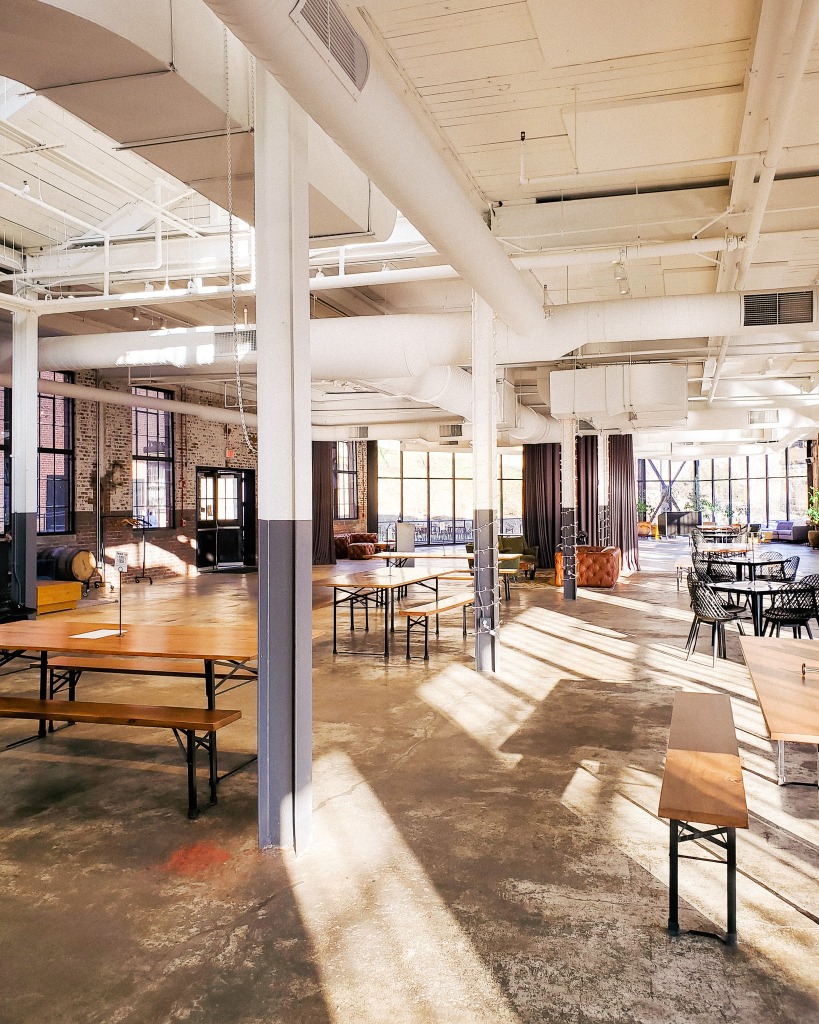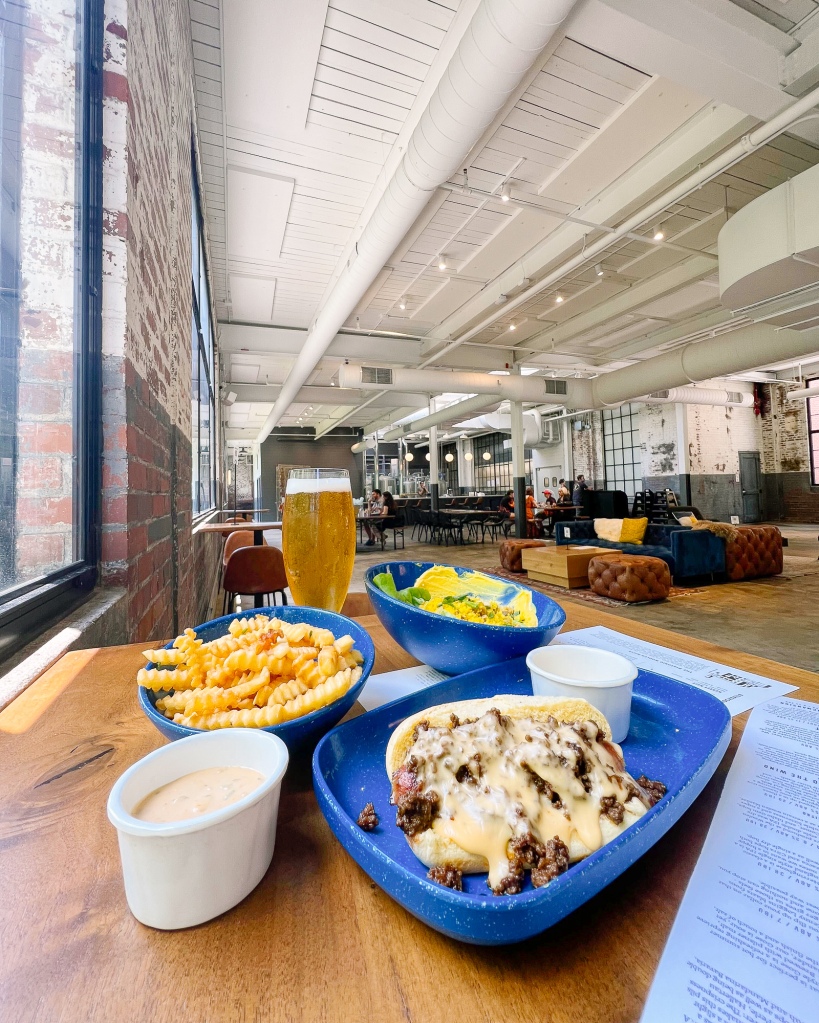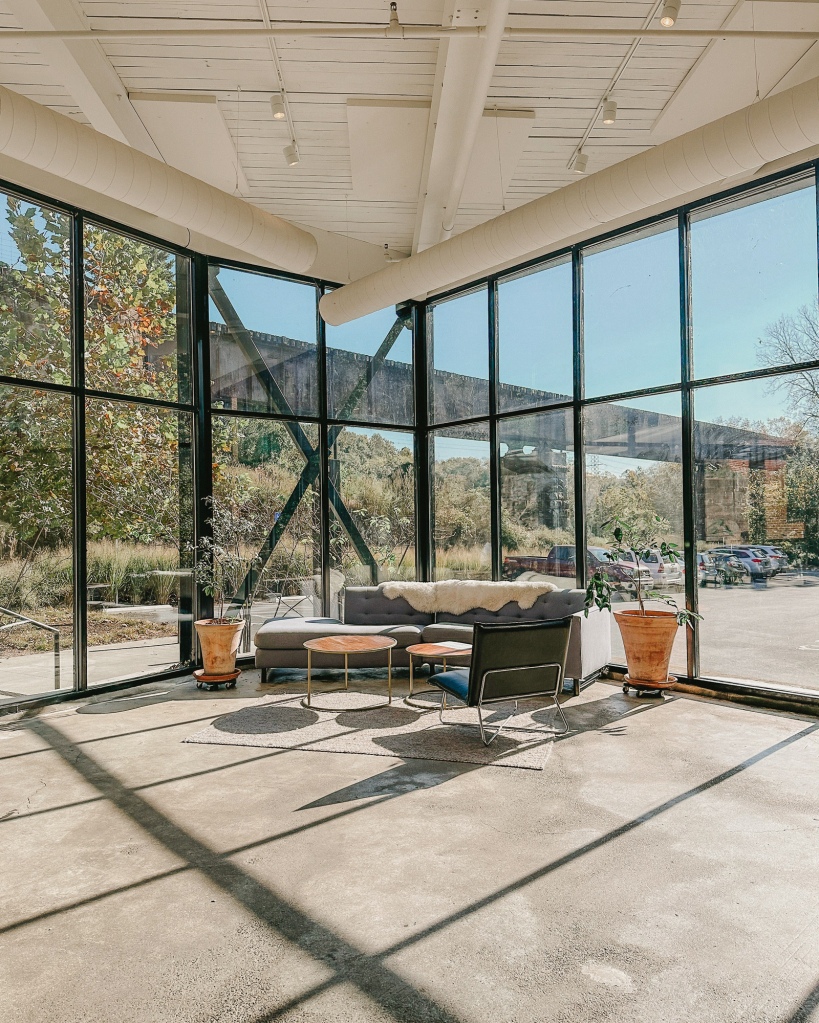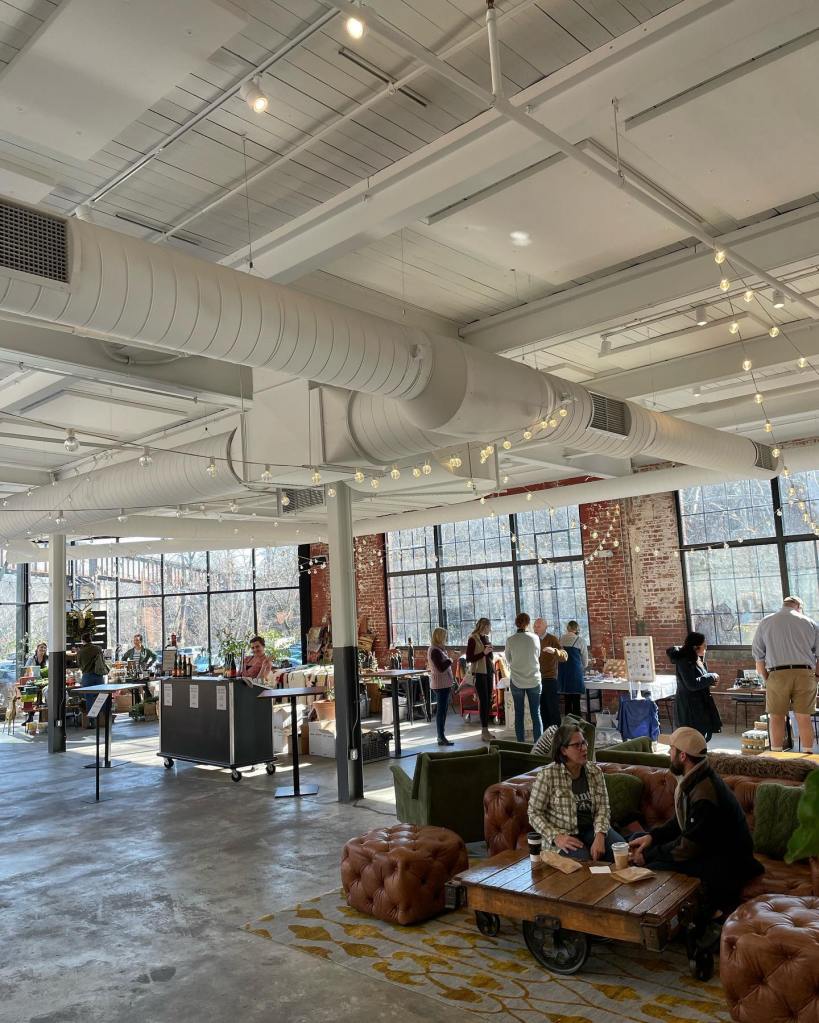Archive for category Restaurants
Project: Dogfish Head Brewing & Eats + Reading a Spectrogram
Posted by Acoustics First in Absorption, Customer Feedback, Product Applications, Products, Restaurants on February 12, 2024
Dogfish Head Brewing & Eats is a brewery, restaurant and performance venue located in Rehoboth Beach, DE. This largely reflective space has a wood ceiling, an un-polished concrete floor and walls comprised of drywall, unfinished wood planks (over OSB) and glass. These hard surfaces promote reverberation and early reflections, resulting in a noisy and “muddy” sounding environment.

Acoustics First and Integrity Sound Solutions were brought in to provide solutions to remediate noise level and clarity issues.
The co-owners of Dogfish Head Brewing & Eats and their house engineer identified a few goals for acoustic treatment…
- Reduce “background” noise as levels in excess of 85dBa were common on busy nights. Under these conditions, the sound engineer would push the sound system above 95dBA to maintain music intelligibility. This results in an acoustically uncomfortable environment for patrons and wait staff (which in turn elevate their voices to be heard, further exacerbating noise level issues).
- Control excessive reverberation and latent reflections to improve live-music clarity.
- Minimize visually obtrusive acoustic treatment, particularly on the main wood ceiling.

Acoustics First recorded numerous sine sweeps using the house system (JBL line array and subs) and a calibrated Zoom H4 recorder as the receiver. The sweep was recorded from a number of positions (in front of stage, main dining area, in front of the bar and from the mezzanine level). The following charts are spectrograms of two of these sweeps. Spectrograms are a visual way of representing sound intensity (volume) across a range of frequencies. We can observe how energy levels compare between frequencies and see the response of the speakers and the room at these frequencies over time.
The spectrograms of the sine sweeps show that the house system is very good at producing the full spectrum of frequencies, which gave us more confidence in our analysis.
Reading the Spectrogram – The thickest sweep line (furthest right) is the direct speaker output and the thinner sweep lines are harmonic resonances of the speakers; you’ll notice these bands get further apart as we move up in frequency. The thickness of the sweep, showing sound intensity over time, represents the extent of early reflections. For example, a sweep recorded in an anechoic chamber would have very tight lines.

The first 6dB of early reflections are the most distracting because of their intensity. Reflections arrive slightly late, but at the same frequency, create a “smear” of sound. The faster they decay (<100ms) the more focus you have on the direct source. As you can see, low and mid frequencies stay extremely elevated for the entire 100ms, resulting in a muddy, undefined sound.
Reverberation Time – Measurement & Analysis:
Reverberation Time (RT60) is a metric that is defined as the time it takes for sound to decay 60 decibels (dB) in a room. This is a very important metric for medium-to-large room acoustics as it dictates how well a room will perform for speech and music applications. Generally, a large room with abundant hard surfaces will have a long reverb time. Surfaces that have sound absorptive qualities, like carpet and acoustic panels, reduce reverberation.
Bars/restaurants of this size with live music should have a reverberation time below 1.2s, ideally in the .6-.8s range for “high-intensity” performances, like Rock, Hip Hop or Electronic Dance Music.
We recorded a balloon pop and the subsequent reverb tail and calculated the reverb time based on the decay rate. The results were as follows.

RT60 measurement of 1.656s was recorded at the center of the room. Although this measurement is shorter than initially expected, it is still excessive given the use of the space.
Reverb Prediction:
We entered the dimensions, construction materials and furnishings of the restaurant into our acoustic calculator and made a prediction of reverb times before and after treatment. The modeled “existing” reverberation time and the measured RT60 results we took on-site were very close @ 2000Hz, which gives us confidence in the acoustical model. This means we can add acoustical treatment to the model and accurately predict the results before any changes are made to the actual room and it shows how much improvement you can expect from the recommended treatment.

As you can see, the treated result in the model is within our target RT60 (.6-1.2s) for amplified live-music, resulting in a more suitable performance environment. This treatment would also significantly reduce noise buildup (in a well-treated room, customers and staff will not feel like they have to shout to be heard), further helping control noise levels.
To minimize the amount of visually noticeable treatment, Acoustics First specified fabric wrapped Sonora Panels (http://acousticsfirst.com/sonora-wall-panels.htm) and factory-painted Tone Tiles panels ( https://www.acousticsfirst.com/acoustic-tone-tile-panels.htm) to match the exact wall color. Acoustics First also recommend Sonora Blackboard https://www.acousticsfirst.com/sonora-black-board.htm to “fit” within the metal beams.
Most of the sound absorptive treatment was broad-band in nature. However, Low-Frequency Control (LFC) panels were utilized on the stage wall (behind the line array) to combat the early bass reflections that degrade low-frequency definition. LFC panels are a specialized absorber that focuses squarely on attenuating low-frequencies, below 250 Hz. View our website for more information – https://www.acousticsfirst.com/sonora-lfc.htm
As you can see from the pictures, Integrity Sound Solutions did amazing job with the installation.

What does the client think? Per the co-owners “The sound quality is exponentially BETTER…. The stuff in the beams just disappears!”
Scoop up some Fireflex™ Waves
Posted by Acoustics First in Absorption, Product Applications, Products, Restaurants on June 6, 2023

Ice cream shops are often places with acoustic challenges. Some have large glass windows, glass freezers, compressors, and other equipment… Let’s not forget all the patrons and excited children! In retail environments like these, good acoustics are important for accurate order taking, customer comfort, and safety concerns. These spaces also require Class A fire rated materials to meet many local fire codes.

The high ceilings were an easy place to put some acoustic treatment without interfering with the activities of the shop and Fireflex™ Waves were an ideal solution. The ceiling-mount Waves can be installed in either a cloud (horizontal) or baffle (vertical) configuration. In this particular space, the perpendicular baffle installation was the most efficient use of the Waves, and their Class A fire rated Fireflex™ material is also easy to cut in the field – which was handy when they had to work around an I-beam.

If you have an environment that needs acoustic treatment, reach out to Acoustics First® online or at 888-765-2900.
Treating a reclaimed space: Tone Tiles®
Posted by Acoustics First in Absorption, Multipurpose Rooms, Product Applications, Restaurants on December 30, 2022
Reclaiming historic spaces and updating them for modern functions is a bit of a balancing act. Often, the aesthetics of the space are tantamount, and should be minimally impacted by the materials and methods used to bring them up to modern standards. Acoustic treatments are no exception, and it is usually best if the materials blend into the space – or at least don’t detract from the overall “vibe.”

When this old factory was converted into a multi-function space with a restaurant and brewery, there were concerns about the build-up of sound. As is often the case, the rustic patina of the concrete and brick surfaces were a focal point in this space, leaving the ceiling as the primary treatment location.

The solution was to install 2″ Tone Tiles® directly to the ceiling. This solution allowed for the sound build-up to be absorbed, while blending into the whitewashed ceiling structure. The rustic charm of the room was maintained, while having a modern, intimate acoustic profile, which is more conducive to gatherings and functions.

Sonora® Wall Panels on the Ceiling?
Posted by Acoustics First in Absorption, HOW TO, Product Applications, Products, Restaurants on February 25, 2022
Sometimes you just don’t have the wall space for acoustic treatment. When this is the case, you will often see treatments move to the ceiling… but what do you do if you have lower ceilings, or many ceiling fans and fixtures?

This ceiling was sloped toward the massive windows on the outside wall, and it had lights and fans running right up the center. Complicating things further, the opposite wall had sconce lighting, doorways, HVAC, and even more windows. Finally, the floor was not carpeted to facilitate cleaning – as is the norm in many dining spaces.

Direct-mount acoustic panels are a great solution in these scenarios. Here we see an array of 4’x4’x2″ Sonora® panels attached to the ceiling in rows running down the length of the space. While our Tone Tiles® are often selected for their ability to blend in aesthetically, this particular installation proves that Sonora® panels wrapped in fabric are also a solid choice.
Sonora® Install – Restaurant Ceiling
Posted by Acoustics First in Absorption, Product Applications, Restaurants on November 26, 2019

Sonora® Acoustical Panels help to tame a loud dining space
Have you ever found yourself enjoying delicious cuisine at a nice restaurant only to become frustrated and distracted by bad acoustics? The food is great, but you can’t hear the person sitting next to you.
It’s a common problem. Luckily, there’s a simple solution.
In the case of this Berkeley, California eatery, they installed a helping of our Sonora® Acoustical Panels directly to their ceiling to help tame their space. Sonora® Panels are an excellent option to help fix sound problems in various bar and restaurant situations, whether they are used on the walls or the ceiling.
And with dozens upon dozens of fabric colors and design options available, you can find something to complement or enhance virtually any décor.

You must be logged in to post a comment.